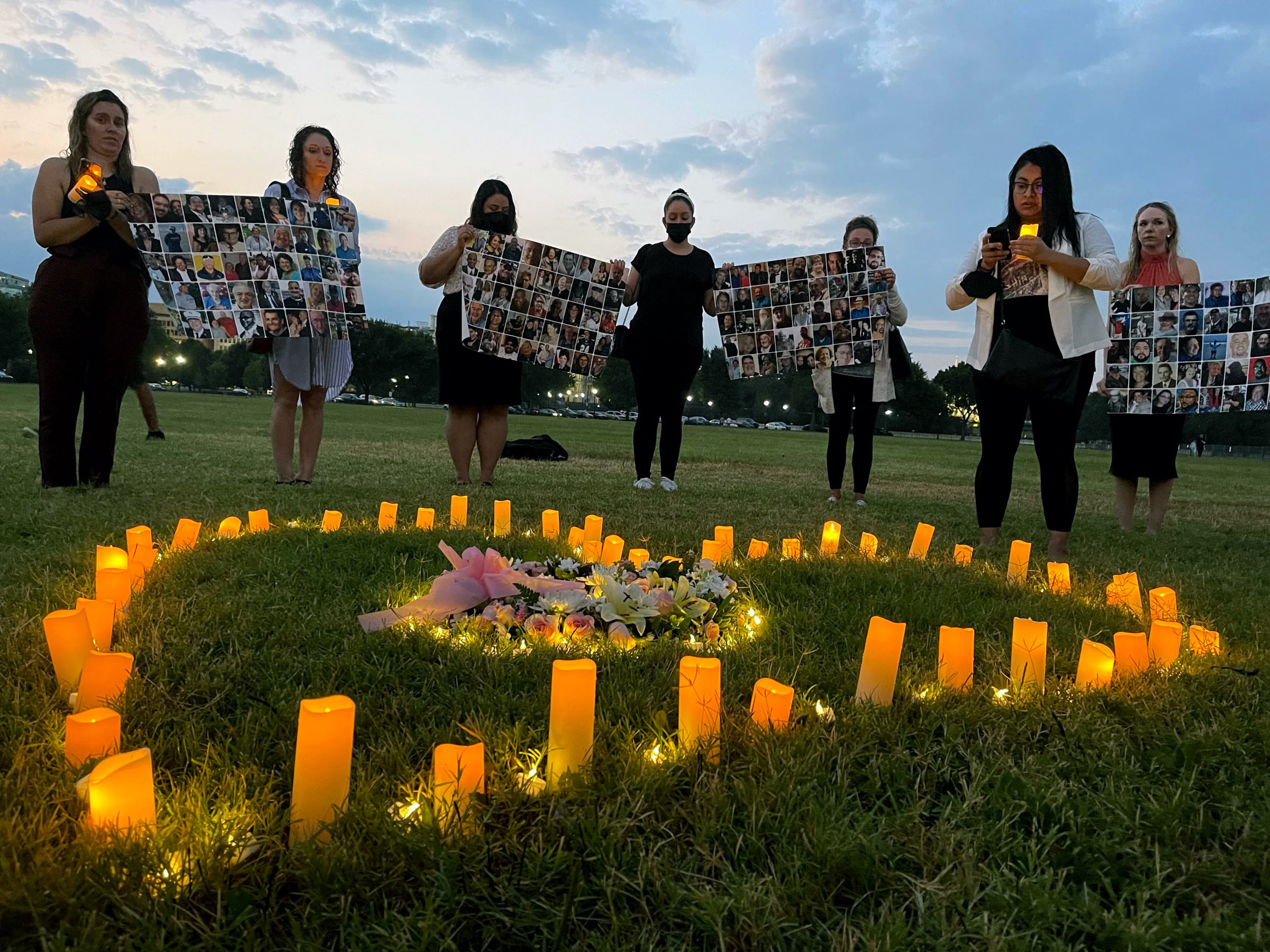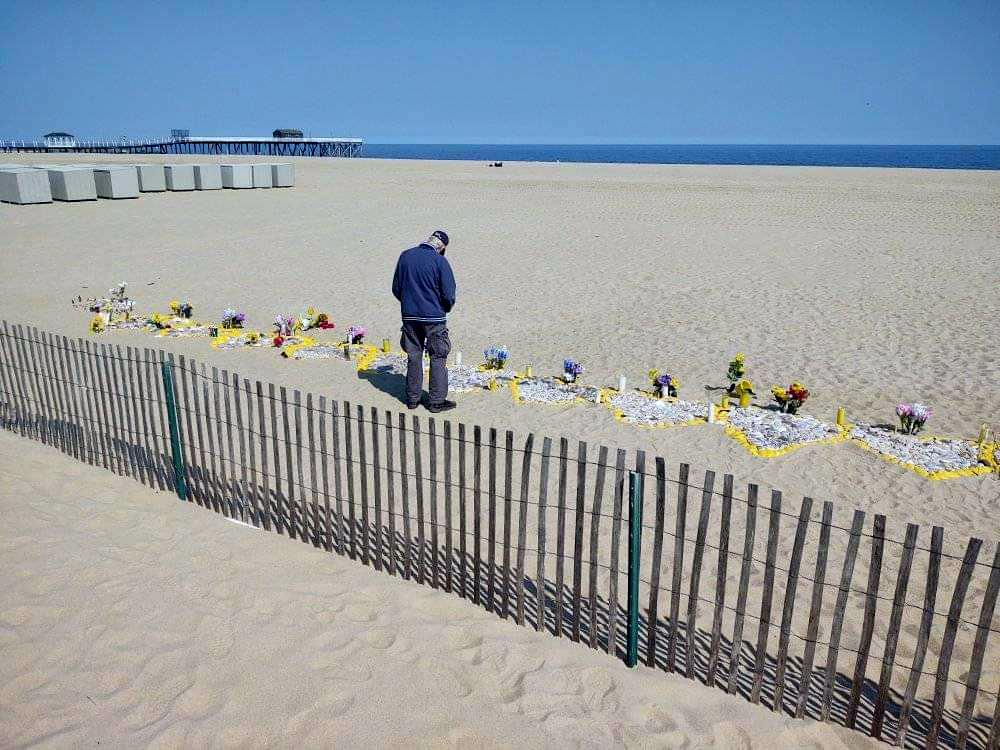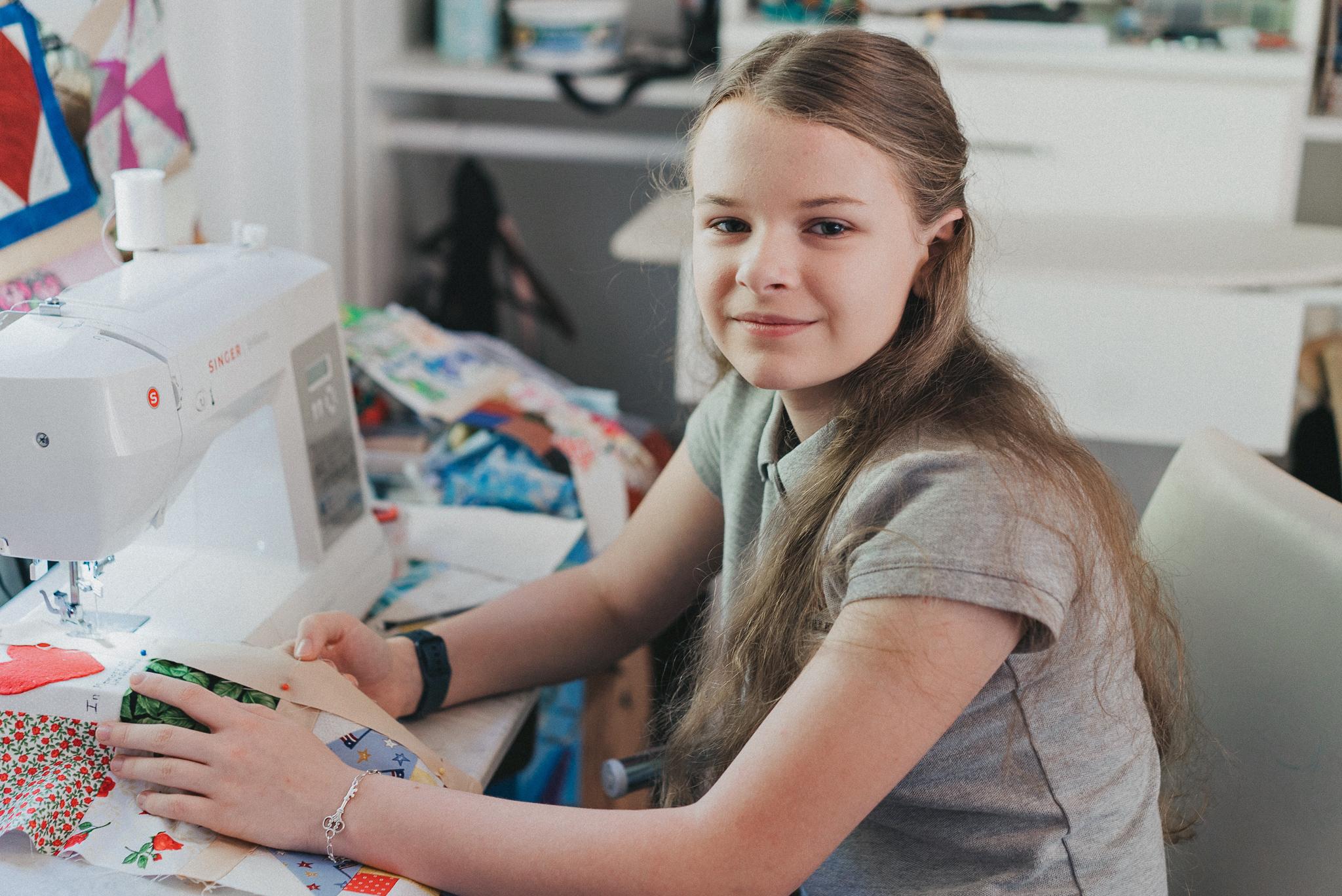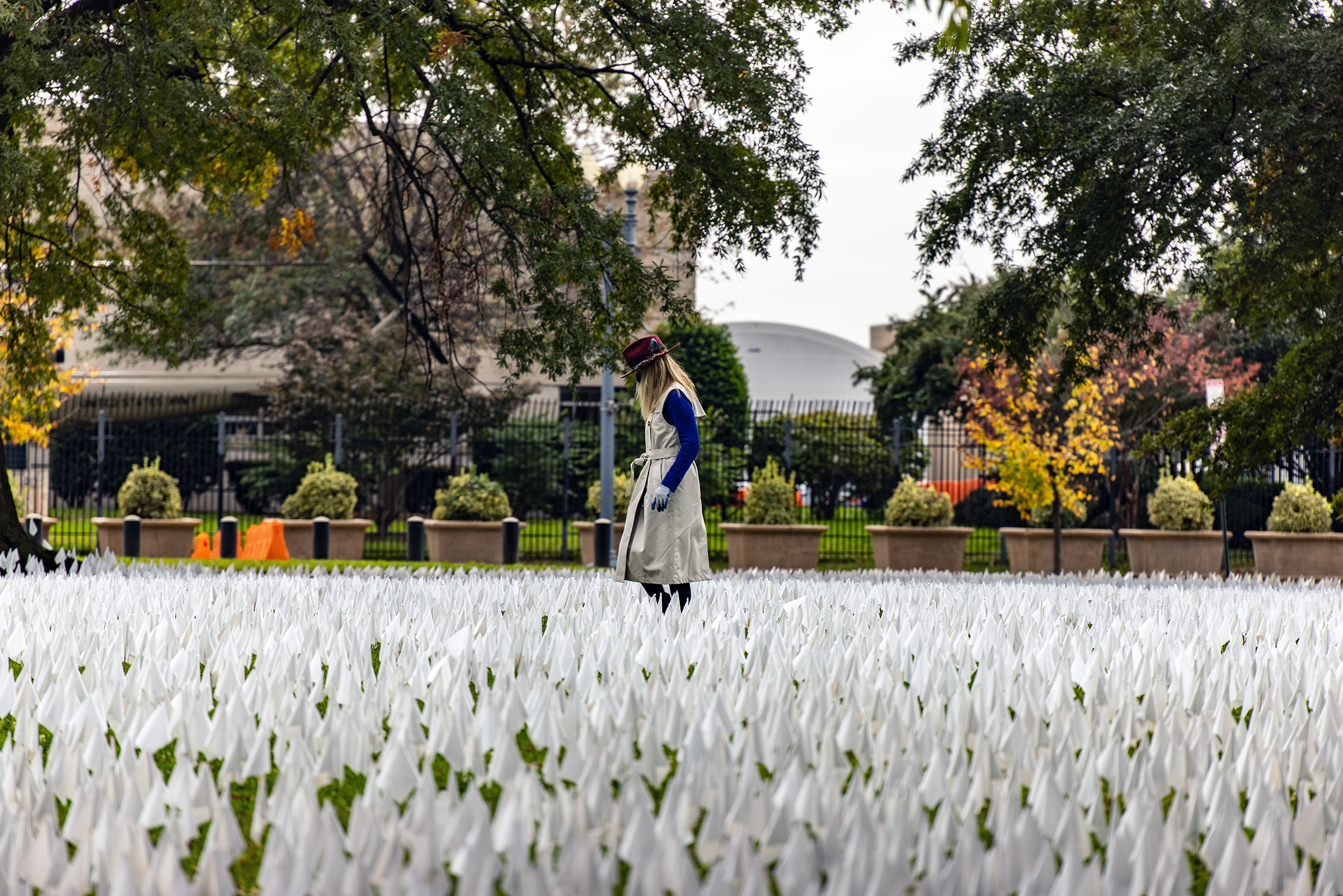
When Rima Samman lost her brother Rami to COVID-19 in May 2020, her family decided to put off holding a funeral until restrictions eased enough to allow them to grieve together with family and friends.
“There’s all these unanswered variables and you’re left wondering, when is the right time?” says Samman to TIME. “I spent about a year mourning him, but without any closure.”
As time passed and the pandemic continued, Samman began to feel like a traditional ceremony or wake wouldn’t provide the comfort she needed. In late January, she decided to create a memorial on the beach in her hometown of Belmar, N.J., to mark what would have been Rami’s 41st birthday.
She spread the word on Facebook, inviting the community to join her to write the names of their loved ones who had died of COVID-19 on stones, then surrounded them with a heart made of yellow-painted sea shells, as a temporary memorial to honor those they lost. Aside from a few friends and family members, Rima didn’t know the 20 or so strangers who gathered that night to light candles and share memories.
“I realized that night how desperate we all are for something tangible.” she says. “I basically thought that I would go to bed that night and go back to clean it up the next day.”
But by the next morning, after someone posted photos of the makeshift memorial to social media, she had received over a hundred messages asking her to add more names to it. As messages continued to come in and strangers began traveling from as far as California to visit the memorial, it became clear the tribute needed to exist for at least a little longer.
“How can you stop when this is all people have?” says Samman.
The number of deaths from the coronavirus pandemic has surpassed 640,000 in the United States, and continues to climb. In response to the ongoing national tragedy, communities around the country are finding their own ways to mourn the individuals within the numbers with local memorials. They are also pushing for permanent, national recognition of the pandemic’s toll. The urge to memorialize follows all tragedies, whether individual or national, and the COVID-19 pandemic highlights important questions about how and why we acknowledge loss.

‘Arguments about the past’
President Joe Biden acknowledged the need to grieve as a nation on the eve of his inauguration, as 400 lights were lit around the Lincoln Memorial Reflecting Pool. “It’s hard sometimes to remember, but that’s how we heal.” He remarked before the lanterns were lit. “It’s important to do that as a nation.”
However, remembering our struggles has not always come easily in the United States. “Monuments and memorials have not traditionally been a source of understanding, they sometimes obscure.” says Paul Farber, the director of the Monument Lab, a public art and history studio that studies how monuments inform history and collective memory.
More Americans died from the 1918 flu than the number of soldiers killed in World War I, yet there are few public memorials or sites of memory that recognize the flu’s death toll. “Our World War I memorials don’t reflect the complications of the interconnected world. They [only] tell a part of the history.” says Farber.
Federally protected monuments are created through congressional legislation or by the President through the Antiquities Act. The U.S. has erected national memorials to recognize losses that have shaped national history and create space for grief. Washington, D.C. alone is home to 12 national memorials honoring the 405,399 Americans who died in World War II, the 58,318 Americans killed in the Vietnam War and countless others. In Pennsylvania, a memorial is dedicated to the 40 Americans who lost their lives on board Flight 93 on 9/11.
On a state and local level, the process of establishing a memorial varies, but has historically come from vocal organizers. For instance, beginning in the early 1900s as states were establishing Jim Crow laws, the United Daughters of the Confederacy lobbied for and sponsored hundreds of Confederate monuments across the South as part of a campaign to shape the remembrance of the Civil War.
Even when monuments and memorials don’t have that kind of overt propaganda goal, they often omit the dark parts of America’s past instead of creating a space to learn from them.
“What happens so often in our history is that monuments end up standing in for the hard conversations that we should really be having about the past.” said Seth Bruggeman, the director of the Center for Public History at Temple University. He says the push in recent years to remove Confederate statues highlights this. “We kind of relied on them to do the remembering for us. In having done that we neglected to talk about stuff like institutional racism, failures of the Civil War, perpetuation of white supremacy. That was getting masked by the monuments.”
No matter how neutral they might seem, monuments “are always arguments about the past,” says Bruggerman. While those arguments have traditionally come from those in power, many activists are already working to ensure that history does not sanitize the stories of those who were most impacted by the pandemic.
Local efforts to mourn nationally
Kristin Urquiza’s father Mark died of complications from COVID-19 in June of 2020, as his hometown of Maryvale — a low-income community with a large population of immigrants and Latinx residents– was in the midst of a surge in cases. Urquiza knew she wanted to channel her grief into something that would help her community, but it wasn’t until the fall, around the anniversary of 9/11, that she realized exactly how she could do so.
“We take time on Sept. 11 every year to read the names [of those lost] and have a moment of silence,” she says, but she had yet to see a similar kind of remembrance for the pandemic, even after the global death toll had just passed one million. Along with a team of volunteers, Urquiza co-founded Marked By COVID, a non-profit pushing to create a permanent form of remembrance and hold the government accountable for lives lost to COVID-19. The group created a temporary memorial outside the Arizona State Capitol, with 500 chairs to mark the 5,900 deaths in Arizona at the time.
Though the memorial was only up for one evening, Urquiza believes it’s important to work towards a permanent memorial that remains long after the immediate memories of the pandemic recede.
“The 9/11 Museum and memorials like the MLK Memorial, really helped ground the history of a time and a moment of national importance.” says Urquiza. The 9/11 memorial, while not a perfect example, is able to use specific details, like artifacts and archival audio, to provide historical context alongside the memorial, leaving visitors with a deeper understanding of the event and its impact. “I just imagine children 20 years from now taking their high school trip to D.C. visiting the COVID Memorial and engaging with this public health crisis.”
She is now advocating for a national holiday to mark the loss, traveling to Washington with other Marked by COVID activists to lobby for it. In response, Senators Edward Markey, Elizabeth Warren and Martin Heinrich introduced a resolution to designate the first Monday in March as COVID–19 Victims and Survivors Memorial Day.
“Having a date in the calendar is something that we can do quickly.” she says. “It doesn’t take a ton of finances, and it’s a way to fight the revisionist history that we’re already experiencing.”
The push by activists like Urquiza to mark the losses is not unique to the COVID-19 pandemic. Many memorials and monuments end up originating from the particular communities experiencing loss, a phenomenon Farber calls “urgent memory.”
“Mourning members of the community and fighting for your own survival often come together in our timelines of grief,” he says.
Farber points to the AIDS Memorial Quilt, conceived in 1985 at the height of the AIDS epidemic. Gay rights activist Cleve Jones created the memorial after over 1,000 San Franciscans had died of AIDs. Activists gathered panels from around the country that bore the names and individualized the losses in the hopes that it would help people understand the disease’s impact and memorialize lives they feared history would not remember.

Madeleine Fugate, a 14-year-old in Los Angeles, Calif., was struck by how COVID-19 deaths were often referenced as numbers rather than the lives behind them. Her mother Katherine had worked on the AIDS Memorial quilt, which inspired her to take up a similar project. “These aren’t statistics or numbers, they’re people.” said Katherine. Madeleine began creating a COVID Memorial quilt in April of 2020, and has continued adding new panels to the project as individuals around the country send them in.
Local COVID-19 memorials have been operating on an adjusted scale, struggling to fully capture the full number of deaths. In Washington D.C., artist Suzanne Firstenberg wanted to create an installation that would allow visitors to visualize the full toll of the pandemic. Last fall, she placed 267,080 white flags outside of RFK Stadium to mark the number of deaths at the time. A year later, she is working to make a second installation that will reflect a death toll that has more than doubled and encourage visitors to personalize the flags with the names of their loved ones.
“Encountering a personalized one and then lifting one’s gaze across this immense field…I think that will help people understand the magnitude of our loss on both an individual basis and on a national basis,” says Firstenberg.
Firstenberg’s re-envisioned memorial will begin under the National Museum of African American History & Culture, a decision Firstenberg made to reflect the disproportionate impact of the virus on Black Americans, and stretch across 20 acres. The project will be on display in September, as schools and some offices plan to return in person, to push back against the idea that the fall could signal a “return to normal.”
“For Americans who lost a family member to COVID, there will be no normal to go back to,” says Firstenberg, who is working with the Smithsonian Museum of American History to archive part of the installation when it comes down.

Political standstill
Though memorials have cropped up within communities to fill the gaps, most have been temporary. Besides the proposed holiday, there has been little movement from the Biden Administration or lawmakers to establish a national memorial; a bill sponsored by Rep. Adriano Espaillat to create a national memorial in Bronx, N.Y., died in the House last summer.
Urquiza says that the gains she has made have been hard won. Even with the platform she has, she has struggled to get access to politicians, and knows others who have had to follow up multiple times just to schedule meetings with staffers at the congressional offices meant to serve them. To her knowledge, the Biden administration has not met with any of the activists pushing for national acknowledgement of the pandemic.
“I have more access than most people and I can’t get a five minute audience with somebody at that level,” she says, “After disasters, the President or Vice President will meet with families. This is a slow disaster that we’re living through.”
“I think the reason that so many people are independently stepping up is because our government is not acknowledging the need for these things,” said Samman. “It’s hard not to want to help people because we’ve experienced the damage and the loss ourselves.”
The seaside memorial that Samman created had to be moved off the beach as summer approached, but she is now in the process of moving the rock bearing her brother’s name to a permanent location in Wall, N.J., along with the over 3,000 other names that later joined it. But for Samman, remembering the toll of the pandemic also means helping those who continue to live through its impact, whether it’s creating space for them to mourn or raising money to financially support widows and widowers who are also navigating a loss of income.
“A memorial shows you the tragedy of a loss of life,” says Samman. “What it doesn’t show you is what that loss has impacted.”
More Must-Reads from TIME
- Donald Trump Is TIME's 2024 Person of the Year
- Why We Chose Trump as Person of the Year
- Is Intermittent Fasting Good or Bad for You?
- The 100 Must-Read Books of 2024
- The 20 Best Christmas TV Episodes
- Column: If Optimism Feels Ridiculous Now, Try Hope
- The Future of Climate Action Is Trade Policy
- Merle Bombardieri Is Helping People Make the Baby Decision
Write to Simmone Shah at simmone.shah@time.com